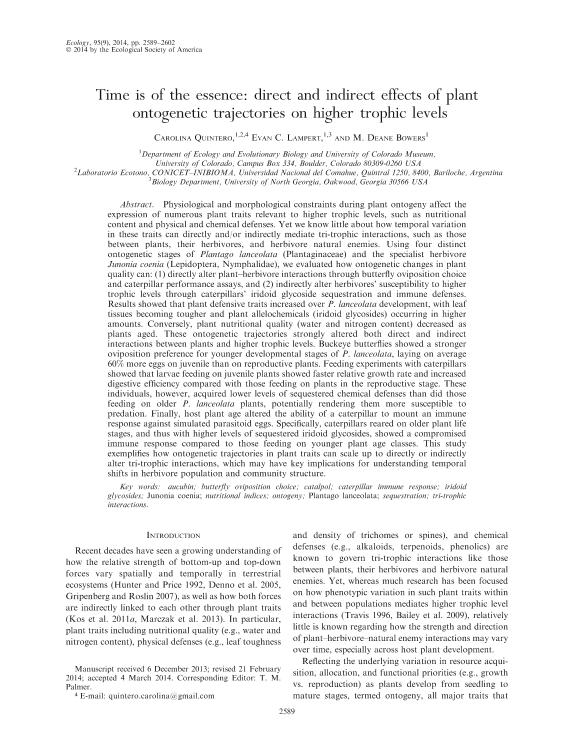Mostrar el registro sencillo del ítem
dc.contributor.author
Quintero, Carolina

dc.contributor.author
Lampert, Evan C.
dc.contributor.author
Bowers, M. Deane
dc.date.available
2017-01-25T18:18:46Z
dc.date.issued
2014-09
dc.identifier.citation
Quintero, Carolina; Lampert, Evan C.; Bowers, M. Deane; Time is of the essence: Direct and indirect effects of plant ontogenetic trajectories on higher trophic levels; Ecological Society Of America; Ecology; 95; 9; 9-2014; 2589-2602
dc.identifier.issn
0012-9658
dc.identifier.uri
http://hdl.handle.net/11336/11902
dc.description.abstract
Physiological and morphological constraints during plant ontogeny affect the expression of numerous plant traits relevant to higher trophic levels, such as nutritional content and physical and chemical defenses. Yet we know little about how temporal variation in these traits can directly and/or indirectly mediate tri-trophic interactions, such as those between plants, their herbivores, and herbivore natural enemies. Using four distinct ontogenetic stages of Plantago lanceolata (Plantaginaceae) and the specialist herbivore Junonia coenia (Lepidoptera, Nymphalidae), we evaluated how ontogenetic changes in plant quality can: (1) directly alter plant-herbivore interactions through butterfly oviposition choice and caterpillar performance assays, and (2) indirectly alter herbivores susceptibility to higher trophic levels through caterpillars iridoid glycoside sequestration and immune defenses. Results showed that plant defensive traits increased over P. lanceolata development, with leaf tissues becoming tougher and plant allelochemicals (iridoid glycosides) occurring in higher amounts. Conversely, plant nutritional quality (water and nitrogen content) decreased as plants aged. These ontogenetic trajectories strongly altered both direct and indirect interactions between plants and higher trophic levels. Buckeye butterflies showed a stronger oviposition preference for younger developmental stages of P. lanceolata, laying on average 60% more eggs on juvenile than on reproductive plants. Feeding experiments with caterpillars showed that larvae feeding on juvenile plants showed faster relative growth rate and increased digestive efficiency compared with those feeding on plants in the reproductive stage. These individuals, however, acquired lower levels of sequestered chemical defenses than did those feeding on older P. lanceolata plants, potentially rendering them more susceptible to predation. Finally, host plant age altered the ability of a caterpillar to mount an immune response against simulated parasitoid eggs. Specifically, caterpillars reared on older plant life stages, and thus with higher levels of sequestered iridoid glycosides, showed a compromised immune response compared to those feeding on younger plant age classes. This study exemplifies how ontogenetic trajectories in plant traits can scale up to directly or indirectly alter tri-trophic interactions, which may have key implications for understanding temporal shifts in herbivore population and community structure.
dc.format
application/pdf
dc.language.iso
eng
dc.publisher
Ecological Society Of America

dc.rights
info:eu-repo/semantics/openAccess
dc.rights.uri
https://creativecommons.org/licenses/by-nc-sa/2.5/ar/
dc.subject
Butterfly Oviposition Choice
dc.subject
Sequestration
dc.subject
Caterpillar Immune Response
dc.subject
Ontogeny
dc.subject
Tri-Trophic Interactions
dc.subject
Iridoid Glycosides
dc.subject.classification
Ecología

dc.subject.classification
Ciencias Biológicas

dc.subject.classification
CIENCIAS NATURALES Y EXACTAS

dc.title
Time is of the essence: Direct and indirect effects of plant ontogenetic trajectories on higher trophic levels
dc.type
info:eu-repo/semantics/article
dc.type
info:ar-repo/semantics/artículo
dc.type
info:eu-repo/semantics/publishedVersion
dc.date.updated
2016-12-12T14:21:39Z
dc.journal.volume
95
dc.journal.number
9
dc.journal.pagination
2589-2602
dc.journal.pais
Estados Unidos

dc.description.fil
Fil: Quintero, Carolina. State University Of Colorado-boulder; Estados Unidos. Consejo Nacional de Investigaciones Científicas y Técnicas. Centro Científico Tecnológico Patagonia Norte. Instituto de Investigación en Biodiversidad y Medioambiente; Argentina. Universidad Nacional del Comahue. Centro Regional Universitario Bariloche. Laboratorio de Ecotono; Argentina
dc.description.fil
Fil: Lampert, Evan C.. University of North Georgia; Estados Unidos
dc.description.fil
Fil: Bowers, M. Deane. State University Of Colorado-boulder; Estados Unidos
dc.journal.title
Ecology

dc.relation.alternativeid
info:eu-repo/semantics/altIdentifier/url/http://onlinelibrary.wiley.com/doi/10.1890/13-2249.1/abstract
dc.relation.alternativeid
info:eu-repo/semantics/altIdentifier/doi/http://dx.doi.org/10.1890/13-2249.1
Archivos asociados
